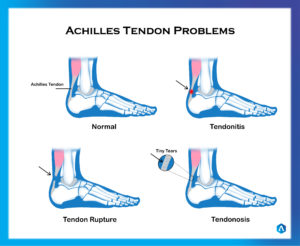Achilles Pain
- Dr Abbie Clinics
- August 19, 2019

The Achilles tendon is the largest tendon in the body, connecting your calf muscles to your heel bone so plays a vital role in helping you walk, run, jump, stand, climb and get around.
Athletes tend to be prone to Achilles pain due to over use and degeneration. It is therefore a tendon that needs to be looked after, athlete or not.
The biomechanical profile of Achilles pain is similar to Plantar Fasciitis as the foot will pronate or supinate, causing a pull on the heel. If this continues then tearing, inflammation and swelling can occur.
Causes are many. This can be from an increase in exercise activity, particularly if this is intense and sudden, or if you have tight calf muscles and take on more exercise. Also bone spurs – where extra bone grows at the heel – can rub against the tendon creating inflammation and pain. Other causes are biomechanical anomalies e.g. having one leg longer than the other creates more stress on the longer leg and its Achilles tendon.
Symptoms
If you are suffering Achilles tendonitis you may experience:
- General inflammation or irritation in the back of your leg down to your heel
- Morning pain and stiffness in the Achilles tendon
- Pain in the tendon or heel which gets worse when more active
- Severe pain following exercise, particularly the next day
- Tendon thickening and pain
- Bone spurs, where extra bone grows at the heel – also known as insertional tendonitis
- Continual swelling which worsens through the day and with activity.
It’s important to note that if you hear of feel a click in the back of your calf or heal you might have torn your tendon. Seeking professional help immediately is advised.
Assessment
To confirm Achilles problems, book a full biomechanical assessment, diagnostic and treatment program. In this situation you may also be sent for an X-ray, ultrasound and if needed an MRI.
Dr Abbie Najjarine, principal at Dr. Abbie Clinics, uses engineering principals to assess the body. Like any materials, tendons have a yield point. He has applied this knowledge to help patients understand the body’s reaction to the activities we tend to inflict on it, and how this applies to a particular individual’s unique body structure and situation.
If left untreated Achilles problems can become severely debilitating.
Treatment
Most common treatments are non-surgical. At Dr. Abbie Clinics we would look at the most immediate ways to relieve pain. This could be one or a combination of the following:
- Stop doing your exercise regime of strenuous activity and rest as much as possible
- Ice the area of pain as required during the day, you can use an ice pack or other method for this, as long as this is done for up to 20 minutes until the skin becomes numb
- Anti-inflammatory medication like Voltaren or ibuprofen help reduce swelling and pain
- Special exercises designed to strengthen and stretch calf muscles to reduce the stress on the Achilles tendon
- Foot mobilisation will help loosen up any tight areas or fix potentially dislocated joints
- Shockwave therapy, where high-energy shockwave impulses are designed to aid the healing process of the damaged area
- Orthotics help support the foot and take strain off the Achilles tendon and reduce irritation at the back of shoes.
- Prolotherapy can help remove adhesions in the area of pain.
- A last resort would be Cortisone injections, although there is risk of tearing the tendon with this procedure.
If you are experiencing symptoms call 1800 DR ABBIE or email reception@dr-abbie.com to organise an assessment.


